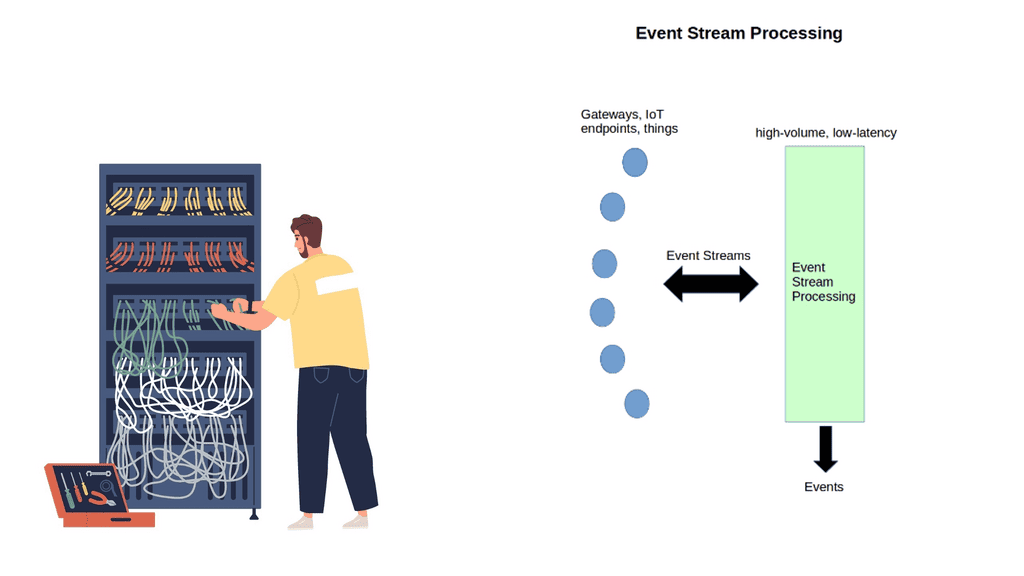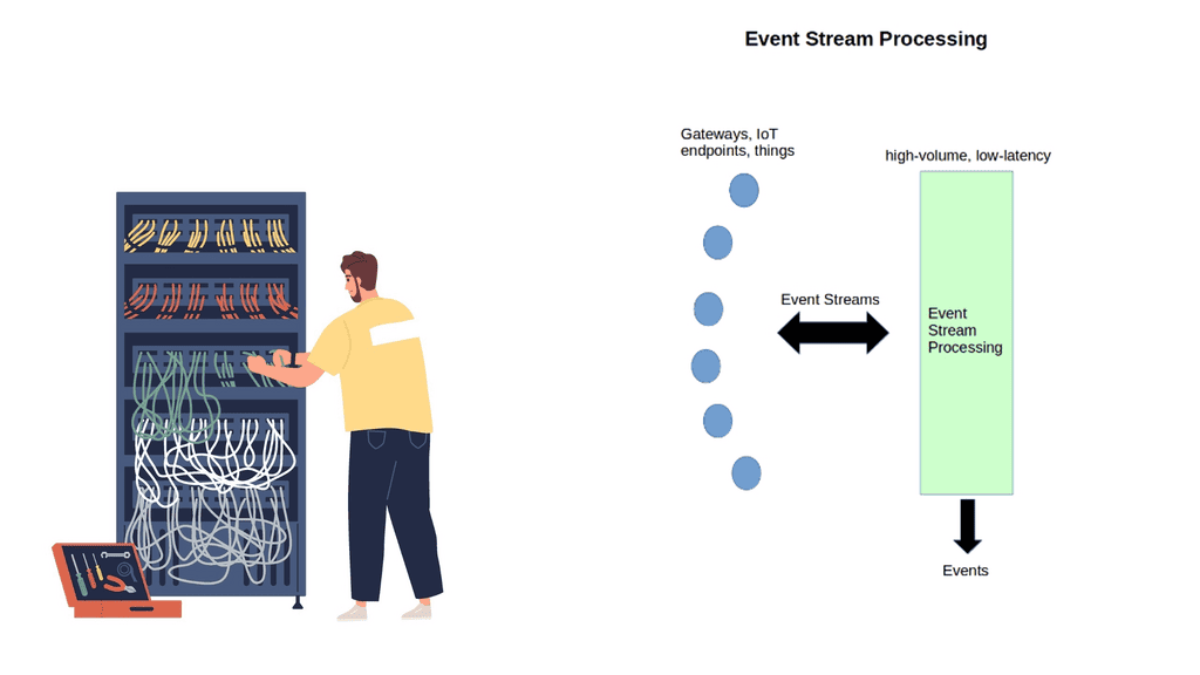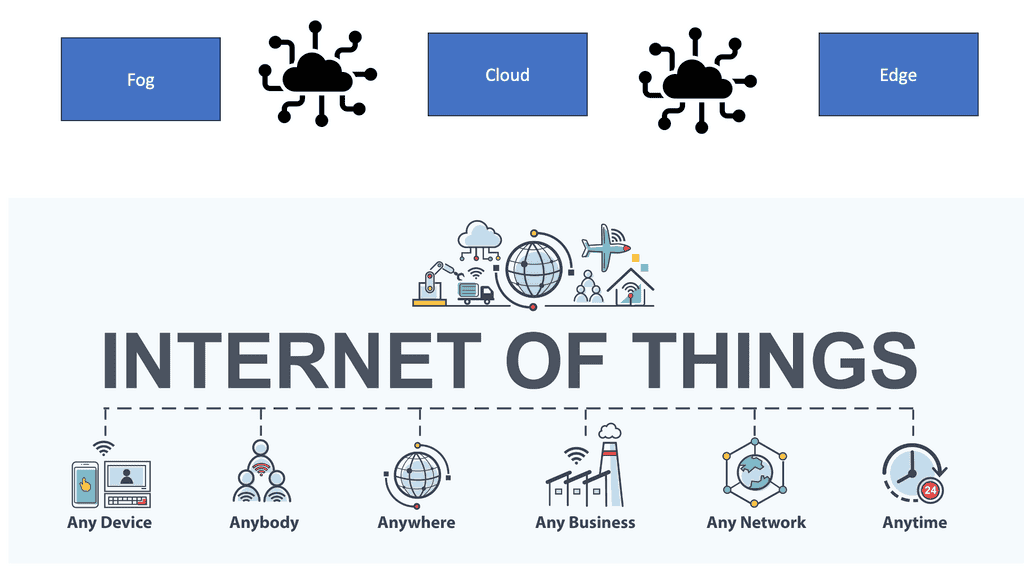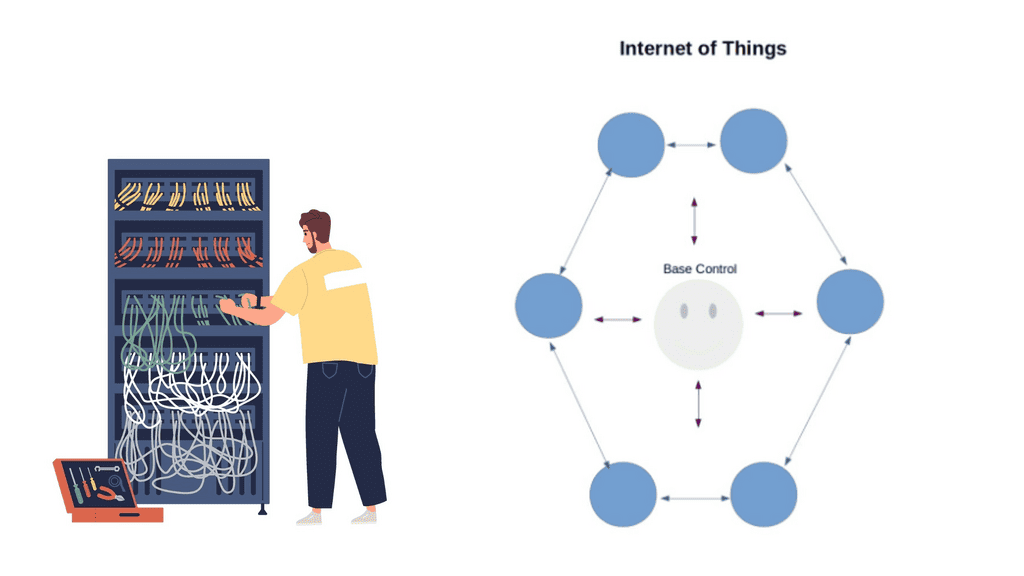Event Stream Processing
In today’s fast-paced digital world, the ability to process and analyze data in real-time has become crucial for businesses across various industries. One technology that has gained significant attention and adoption is Event Stream Processing (ESP). In this blog post, we will explore what ESP is, its benefits, and its applications in different domains.
Event Stream Processing refers to the ability to process and analyze a continuous flow of events or data in real-time. These events can be generated from a variety of sources, such as sensors, social media feeds, financial transactions, clickstreams, and more. ESP systems are designed to handle high volumes of data and analyze it in real-time, allowing organizations to derive valuable insights and make data-driven decisions.
Highlights: Event Stream Processing
- Massive Amounts of Data
It’s a common theme that the Internet of Things is all about data. IoT represents a massive increase in data rates from multiple sources that need to be processed and analyzed from various Internet of Things access technologies. In addition, various heterogeneous sensors exhibit a continuous stream of information back and forth, requiring real-time processing and intelligent data visualization with event stream processing (ESP) and IoT stream processing.
- Data Flow
This data flow and volume shift may easily represent thousands to millions of events per second. It is the most significant kind of “big data” and will exhibit considerably more data than we have seen on the Internet of humans. Processing large amounts of data from multiple sources in real time is crucial for most IoT solutions. Making reliability in distributed system a pivotal factor to consider in the design process.
- Data Transmission
Data transmitted between things instructs how to act and react to certain conditions and thresholds. Analysis of this data turns data streams into meaningful events, offering unique situational awareness and insight into the thing transmitting the data. This analysis allows engineers and data science specialists to track formerly immeasurable processes.
Before you proceed, you may find the following helpful:
- Docker Container Security
- Network Functions
- IP Forwarding
- OpenContrail
- Internet of Things Theory
- 6LoWPAN Range
Event Stream Processing. |
|
Back to basics with Stream processing technology
Stream processing technology is increasingly prevalent because it provides superior solutions for many established use cases, such as data analytics, ETL, and transactional applications. It also enables novel applications, software architectures, and business opportunities. With traditional data infrastructures, data and data processing have been omnipresent in businesses for many decades.
Over the years, the collection and usage of data have grown consistently, and companies have designed and built infrastructures to manage that data. However, the traditional architecture that most businesses implement distinguishes two types of data processing: transactional processing and analytical processing.
- A key point: Analytics and data handling are changing.
All this type of new device information enables valuable insights into what is happening on our planet, offering the ability to make accurate and quick decisions. However, analytics and data handling are challenging. Everything is now distributed to the edge, and new ways of handling data are emerging.
To combat this, IoT uses emerging technologies such as stream data processing with in-stream analytics, predictive analytics, and machine learning techniques. In addition, IoT devices generate vast amounts of data, putting pressure on the internet infrastructure. This is where the role of cloud computing comes in useful. Cloud computing assists in storing, processing, and transferring data in the cloud instead of connected devices.
Benefits of Event Stream Processing
One of the key benefits of Event Stream Processing is its ability to provide real-time insights. Traditional batch processing involves storing data and analyzing it in batches, which can lead to a delay in obtaining insights. ESP, on the other hand, enables organizations to react and respond to events as they happen, leading to faster decision-making and improved operational efficiency.
Another advantage of ESP is its ability to handle complex event patterns. ESP systems can detect and process complex event patterns in real-time, allowing organizations to identify and respond to critical situations promptly. For example, in the financial industry, ESP can be used to detect fraudulent transactions by analyzing patterns and anomalies in real-time, enabling immediate action to prevent financial loss.
Event Stream Processing Application
Event Stream Processing finds applications in various domains. In the retail industry, ESP can be used to analyze customer behavior and preferences in real-time, allowing retailers to personalize offers and improve customer experience.
In the healthcare sector, ESP can be leveraged to monitor patient data in real-time, enabling early detection of critical conditions and timely intervention. In the transportation industry, ESP can provide real-time insights into traffic patterns, helping to optimize routes and improve transportation efficiency.
To implement Event Stream Processing, organizations can utilize various technologies and tools. Some popular ESP frameworks include Apache Kafka, Apache Flink, and Apache Storm. These frameworks provide the necessary infrastructure and processing capabilities to handle high-speed data streams and perform real-time analytics.
IoT Stream Processing: Distributed to the Edge
IoT represents a distributed architecture. We have the distribution of analytics from the IoT platform, either cloud or on-premise, to network edges, making analytics more complicated. A lot of the filtering and analysis is carried out on the gateways and the actual things themselves. These types of edge devices process sensor event data locally.
Some can execute immediate local responses without contacting the gateway or remote IoT platform. A device with sufficient memory and processing power can run a lightweight version of an Event Stream Processing ( ESP ) platform.
For example, Raspberry PI supports complex-event processing ( CEP ). Gateways ingest event streams from sensors and usually carry out more sophisticated steam processing than the actual thing. Some can send an immediate response via a control signal to actuators, causing a state change.
Technicality is only one part of the puzzle; data ownership and governance are the other.
Time Series Data – Data in Motion
The reaction time must be immediate without delay in specific IoT solutions, such as traffic light monitoring in smart cities. This requires a different type of big data solution that processes data while it’s in motion. In some IoT solutions, there is too much data to store, so the analysis of data streams must be done on the fly while being transferred.
It’s not just about capturing and storing as much data as possible anymore. The essence of IoT is the ability to use the data while it is still in motion. Applying analytical models to data streams before they are forwarded enables accurate pattern and anomaly detection while they are occurring. This analysis offers immediate insight into events enabling quicker reaction times and business decisions.
Traditional analytical models are applied to stored data offering analytics for historical events only. IoT requires the examination of patterns before data is stored, not after. The traditional store and process model does not have the characteristic to meet the real-time analysis of IoT data streams.
In response to new data handling requirements, new analytical architectures are emerging. The volume and handling of IoT traffic require a new type of platform known as Event Stream Processing ( ESP ) and Distributed Computing Platforms ( DCSP )

Event Stream Processing ( ESP )
ESP is an in-memory real-time process technique enabling the ability to analyze continuously flowing events in data streams. Assessing events in motion is known as “event streams.” This reveals what is happening now and can be used with historical data to predict future events accurately. To predict future events, predictive models are embedded into the data streams.
This type of processing represents a shift in how data is processed. Data is no longer stored and processed; it is analyzed while still being transferred, and models are applied.
ESP applies sophisticated predictive analytics models to data streams and then takes action based on those scores or business rules. It is becoming popular in IoT solutions with predictive asset maintenance and real-time detection of fault conditions.
For example, you can create models that signal a future unplanned condition. This can then be applied to ESP, quickly detecting upcoming failures and interruptions. ESP is also commonly used in network optimization of the power grid and traffic control systems.
ESP is in-memory, meaning all data is loaded into RAM. It does not use hard drives or substitutes, resulting in fast processing, enhanced scale, and analytics. In-memory can analyze terabytes of data in just a few seconds and can ingest from millions of sources in milliseconds. All the processing happens at the system’s edge before data is passed to storage.
How you define real-time depends on the context. Your time horizon will depict whether you need the full power of ESP. Events with ESP should happen close together in time and frequency. However, if your time horizon is over a relatively long period and events are not close together, your requirements might be fulfilled with Batch processing.
Batch vs Real-Time Processing
With Batch processing, files are gathered over time and sent together as a batch. It is commonly used when fast response times are not critical and for non-real-time processing. Batch jobs can be stored for an extended period and then executed; for example, an end-of-day report is suited for batch processing as it does not need to be done in real-time.
However, they can scale, but the batch orientation limits real-time decision-making and IoT stream requirements. Real-time processing involves a continual input, process, and output of data. Data is processed in a relatively small period. When your solution requires immediate action, real-time is the one for you. Examples of batch and real-time solutions include Hadoop for batch and Apache Spark focusing on real-time computation.
Hadoop vs Apache Spark
Hadoop is a distributed data infrastructure that distributes data collections across nodes in a cluster. It includes a storage component called Hadoop Distributed File System ( HDFS ) and a processing component called MapReduce. However, with the new requirements for IoT, MapReduce is not the answer for everything.
MapReduce is fine if your data operation requirements are static, and you can wait for batch processing. But if your solution requires analytics from sensor streaming data, then you are better off using Apache Spark. Spark was created in response to the limitations of MapReduce.
Apache Spark does not have a file system and may be integrated with HDFS or a cloud-based data platform such as Amazon S3 or OpenStack Swift. It is much faster than MapReduce and operates in memory and real time. In addition, it has machine learning libraries to gain insights from the data and identify patterns. Machine learning can be as simple as a python event and anomaly detection script.




